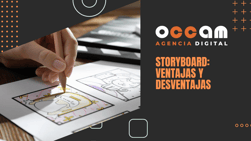Index Content
A few days ago, we told you what storyboarding is, what it's for and where it can be used. Do you remember it? We want to go a step further and tell you about its varieties. It all starts with the design and choice of shots, the movement, the music... And ends in a fantastic film with graphic elements and key moments represented. The marketing and advertising universe has welcomed it with open arms.
find out for yourself in this post.
Remembering what storyboarding is
Nothing more and nothing less than a set of images or graphics represented in a sequential way, something like a visual guide where we are shown different images numbered and ordered chronologically to preview an animation, to understand a story or to plan the structure of a film.
They represent the key frames of a script. You just need to remember a series of steps: timeline, key moments to highlight, medium where you are going to represent it, new ideas, complementary information and the programme you are going to use to create it.
all clear?
4 types of storyboard you need to know
In advertising, it is common to use a more general visual guide for the producer and director to give their opinion, introduce changes and enrich the script. This is different in cinema, where it takes on a much more technical and elaborate character.
The most commonly used by brands are:
- Animated storyboarding. These can be individual sketches in order to create a sense of time and movement. With the addition of music and dialogue, animations can give a much greater sense of visual flow and time.
- Storyboard digimatics replace sketches with digital images stitched together to create a sense of time and movement. They are similar to animated storyboards and are used in advertising to visualise advertisements. They can be used to make test films.
- Thumbnail storyboarding is usually small and collected on a single sheet of paper. it is drawn much faster than the other varieties of storyboarding and uses scribbles in the action panel as well as sketches before creating the details.
- Traditional storyboards are pencil or pen drawings created by an artist under the supervision of the producer or director, and will follow the guidelines set by the filmmaker, client or producer, although it is common for the director to create his or her own storyboard to taste.
These illustrated representations of your video script are perfectly applicable to the world of marketing. It all depends on the type of video you are going to make (for a sales page, a product launch, etc.). Think about the visualisation you want to convey to your audience, because we are all visual and our brains are ready to receive your audiovisual piece.
do you have a clear idea of how you are going to create it?
why is it essential for your digital marketing strategy?
You already know that video is vital for any company. It is easy to understand, loud and clear, connects with the audience, increases brand visibility and all those things you already know. The storyboard is part of the video, therefore, you have to take care of it to get good results in your digital marketing strategy. You will see:
- The storyboard is fundamental when presenting video ideas to the client.
- It isthe most graphic, representative, simple and selling way to show the production in a digital marketing plan.
- Video is used for a variety of purposes: from presenting a product, to introducing a company or announcing new content.
- Itallows to describe functionalities and interaction simultaneously .
- Itdoes not require programming and generates a complete description.
You can make your own as you prefer, from the simplest, with a sheet of paper and a pencil, to the most creative, with animation. It all depends on the resources you have. Often, we skip some steps to save time and money that we do not have. In this case, we recommend that you go to a professional for guidance.
The storyboard is a previous step that will allow you to plan your video to ensure that you get the images of those key contents that the final production is about. If you don't do it well, it may happen that the narration does not have chemistry with the images that are shown. Divide the text into as many parts as you think necessary. And don't tell in the narration everything you see in the storyboard, but you must provide complementary data and explain what is seen.
The storyboard is fundamental for the client and the agency to be certain of what is going to be done, as well as the certainty that the brand is clearly aligned with the goals set before investing or producing .
do you already know where to start? Do you know the importance of video? Do you have any doubts? We are 'all ears'.




